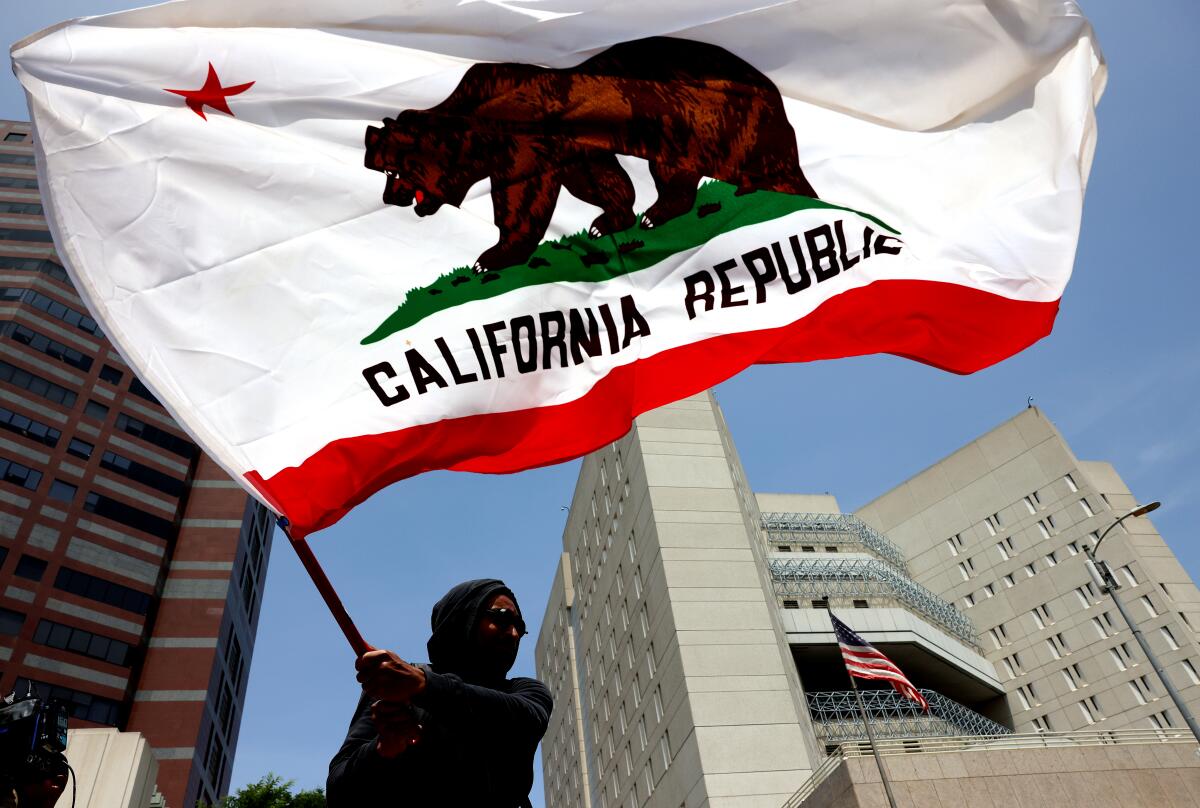Can Newsom block tax payments to the U.S. government? No, but we do give more than we get back

- Share via
California Gov. Newsom threw down the gauntlet to Donald Trump last week after Trump threatened to cut off all federal funding to the state.
In a post Friday on X, Newsom observed: “We pay over $80 BILLION more in taxes than we get back” from the federal government. “Maybe it’s time to cut that off.”
Let’s get the fundamental points out of the way right off. First, both threats are fanciful to the point of serving as performance art.
The administration has been trying to portray this as a one-way street, that they provide all these dollars to California and somehow California is not deserving or worthy of them compared to the other 49 states.
— H.D. Palmer, California Dept. of Finance
Trump’s efforts to cut off congressionally allocated funds to public and private recipients have already run into a judicial buzzsaw, as would his threat to California were he to try to put it into action. In lawsuits brought by recipients of grants and loans, several federal judges have blocked Trump’s actions.
In perhaps the most embarrassing climb-down by Trump, on Jan. 29 his budget office rescinded a memo freezing billions of dollars in expenditures by federal agencies — just a day after it had issued the memo.
Get the latest from Michael Hiltzik
Commentary on economics and more from a Pulitzer Prize winner.
You may occasionally receive promotional content from the Los Angeles Times.
I asked the White House to be more specific about Trump’s threat, and was told, “No decision has been made at this time.”
On the other side of the ledger, nothing could be clearer than that the state has zero power to block the payment of federal taxes by California residents.
This is money that never passes through the state’s hands, and in any event it’s the responsibility of individual taxpayers (or their employers, when the money is withheld from paychecks) to make the payments. The state does withhold taxes from its employees’ paychecks, but the law mandates that it forward those withheld funds to the IRS just like private employers.
“The Governor is not suggesting that individual taxpayers cease paying their federal taxes,” a spokesperson for Newsom told me by email. “However, the state is looking at all options to protect the interests of the people of California, including determining whether there are potential options that would allow it to retain some of the funding it typically sends the federal government.” The office didn’t specify further what that funding comprises.
Newsom was making a larger point, however.
Maine Gov. Janet Mills upbraided Trump over his transgender policies. Was his cancellation of a key Social Security policy in her state a retaliation?
“The administration has been trying to portray this as a one-way street, that they provide all these dollars to California and somehow California is not deserving or worthy of them compared to the other 49 states,” says H.D. Palmer, the spokesman for the state Department of Finance. “If we really want to have an honest conversation about inflows and outflows and the dollars that California provides to Washington, let’s have a serious discussion. That’s not what’s happening here.”
Newsom amplified his point about California’s contribution to the federal treasury — albeit without the threat to cut it off — in an official statement also issued Friday. “Simply put,” he said, “as California goes — so goes the country.”
Trump hasn’t specified what money he’s threatening to cut off. But a look at the role of federal funding in the state budget provides an indication that sustenance for millions of Californians hangs in the balance, making this fight more than merely a contest of political micturition.
The state budget for fiscal 2025 includes about $1.8 billion in the federal government’s contribution to the state’s school lunch program, which serves more than 1.5 million schoolchildren. An additional roughly $101 billion is the federal share of California’s Medicaid program, known as Medi-Cal, in which 15 million Californians are enrolled.
Some $20 billion represents the federal contribution to California’s substance abuse and mental health services, and $1.3 billion defrays the cost of supplemental food stamps for women, infants and children.
That’s a lot of money, but Newsom was right to observe that it’s dwarfed by the money that California taxpayers send to Washington — and through Washington to most of the other states of the union.
California consistently has been a “donor state,” one whose residents pay more to the federal government than the state gets in return.
The recent figures are compiled annually by the New York-based Nelson A. Rockefeller Institute of Government, which adds up grants, contract payments, wages of federal employees, and Social Security and Medicare benefits paid to residents of every state, and matches them against federal personal and payroll taxes and other receipts to calculate a balance of payments for each state. (California doesn’t count employee wages or Social Security and Medicare benefits as budget items.)
Congressional Republicans want to preserve tax cuts for the rich by cutting Medicaid, Medicare, Obamacare, green energy and much more.
The Rockefeller Institute notes that the “taking” states — those that receive more than their residents pay out — tend to be those with high poverty rates, due to assistance programs such as the Supplemental Nutrition Assistance Program (SNAP, or food stamps) and Medicaid; those with a high proportion of seniors, due to Social Security and Medicare; those hosting big defense contractors and military bases; and those with lots of federal employees (Virginia and Maryland being the poster children in that category).
At least since 2015, California has ranked among the top five “donor” states as measured by their balance of payments, but not counting the extraordinary COVID assistance payments in 2020-22. It ranked first in 2018, 2021 and 2022 (apart from COVID assistance) and second (behind New Jersey) in 2019.
The COVID benefits, which transferred pandemic costs to the federal government, severely skewed the balance-of-payments math; in 2020 and 2021, no state was a “donor” state.
If anything, Newsom may even have downplayed the size of California’s negative balance of payments with the federal government. The $83-billion figure he and others have cited was the Rockefeller Institute’s figure for fiscal 2022, including the government’s COVID assistance.
Disregarding the COVID funding for 2022, California’s excess contribution to the federal government rises to a record $126.5 billion. In both calculations — with or without the COVID funding — California’s excess of payments over receipts is nearly three times that of the runner-up (New Jersey if COVID is included, New York if it’s not).
That brings us to the question of what all these calculations mean. The last time I addressed the question, in 2010, it was because then-Gov. Arnold Schwarzenegger asserted that the imbalance was the cause of the state’s budget deficit.
Republicans want to cut Social Security benefits and protect the 1% from paying their share in taxes; Democrats know we can afford to raise benefits.
Schwarzenegger complained that California received only 78 cents back from the feds for every dollar it sent to Washington, based on contemporary calculations by the Tax Foundation. (The Rockefeller Institute calculated California’s return on its dollar in 2022 as 88 cents including the COVID aid, 82 cents without it.)
Schwarzenegger made a pilgrimage to Washington to cadge more money from the government, but came home empty-handed. The root cause of the deficit, I noted then, was Schwarzenegger’s decision to rescind the state’s car tax without finding a replacement revenue stream, blowing a hole of as much as $6 billion a year in the budget.
This time around, the donor-state issue wouldn’t be very relevant to any governmental policy, except that red state politicians have been trying to cut off federal funding to California, based on the notion that the state is somehow uniquely wasteful of federal resources.
Among the champions of the asinine idea that disaster aid for the victims of the January wildfires should be conditioned on changes in state policies were Trump and House Speaker Mike Johnson (R-La.), whose state’s land-use policies have contributed to the devastating effects of the hurricanes that regularly visit its shores.
The truth is that California runs a revenue deficit with the rest of the United States in part because it’s the biggest, richest state with the biggest, most successful economy. Those factors generate a tidal wave of tax revenue, especially among the state’s highest-income professionals and entrepreneurs, thanks to the progressive structure of U.S. tax rates.
Another part of the equation is that California has a relatively low poverty rate (it ranks 23rd among the states), so its residents receive proportionately less in federal economic assistance than most other states.
Those are the major factors in almost any state’s balance-of-payments. “No number of military bases or other goodies is going to make up for having a disproportionately large number of high-income people,” Bill Ahearn, then the director of policy for the Tax Foundation, told me in 2010.
In terms of its donor status, California is a victim of is own success. No other state can boast its combination of high income and relatively low poverty, the ineluctible formula subsidizing high-poverty/low-income states, which are concentrated in the Southeast and are mostly led by Republicans.
They would be getting a lot less from the federal government without states like California to fill the Treasury’s coffers. Not that we Californians expect any gratitude. That’s politics.
More to Read
Insights
L.A. Times Insights delivers AI-generated analysis on Voices content to offer all points of view. Insights does not appear on any news articles.
Viewpoint
Perspectives
The following AI-generated content is powered by Perplexity. The Los Angeles Times editorial staff does not create or edit the content.
Ideas expressed in the piece
- California Governor Gavin Newsom highlighted that the state contributes over $80 billion more in federal taxes than it receives in return, framing this imbalance as a rationale to challenge federal funding threats[2]. He emphasized that federal funding supports critical programs like Medi-Cal (serving 15 million residents) and school lunches (1.5 million children), but stressed that California’s economic success inherently fuels its disproportionate tax contributions[2].
- The article clarifies that Newsom’s suggestion to “cut off” federal payments is rhetorical, as state law mandates forwarding withheld taxes to the IRS, and individuals remain responsible for timely payments[2]. A state spokesperson clarified that Newsom is exploring options to retain some state-sent federal funds, though specifics were not provided[2].
- Analysis from the Rockefeller Institute of Government supports California’s status as a top “donor state,” with a $126.5 billion net outflow to the federal government in 2022 (excluding COVID aid). This is attributed to the state’s high-income population and relatively low poverty rate, which reduce its eligibility for federal assistance programs[2].
Different views on the topic
- The Trump administration characterized federal funding as a “one-way street,” implying California mismanages resources compared to other states. However, federal judges have repeatedly blocked attempts to withhold congressionally allocated funds, such as grants for disaster relief[1][2].
- Critics, including House Speaker Mike Johnson, have argued that federal disaster aid—such as wildfire relief—should be contingent on state policy changes. This contrasts with IRS provisions offering tax relief to California wildfire victims, which exclude qualified relief payments from taxable income regardless of their source[1].
- While the administration frames California’s tax burden as a policy failure, the article counters that the state’s economic productivity and progressive tax structure naturally benefit lower-income states, particularly in the GOP-led Southeast, which rely heavily on federal redistribution[2].
Get the latest from Michael Hiltzik
Commentary on economics and more from a Pulitzer Prize winner.
You may occasionally receive promotional content from the Los Angeles Times.














